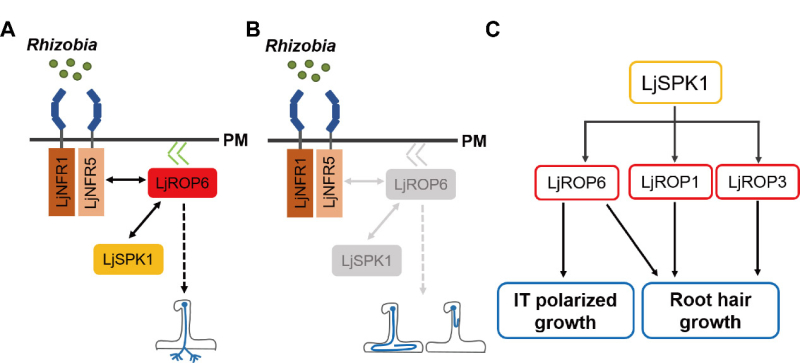A new study reveals the polar growth mechanism of infection threads during nitrogen fixation in Lotus japonicus
Nitrogen is an essential nutrient for plant growth and development. Legume plants not only can take up mineral N from the soil, but also can obtain organic nitrogen derived from gaseous N2 by establishing a symbiotic interaction with rhizobia. During symbiotic nitrogen fixation between legumes and rhizobia, the host legume secretes flavonoid compounds that function as signals recognized by rhizosphere rhizobia, and then rhizobia produce Nod Factors (NFs), compounds which are perceived by the host plant to activate a common symbiosis signaling transduction pathway. Endosymbiotic rhizobia enter nodule primordia via a specialized transcellular compartment known as infection thread (IT). The IT elongates by polar tip growth, following the path of the migrating nucleus along and within the root hair cell. Rho-family ROP GTPases are known to regulate the polar growth of cells, but their role in regulating the polar growth of ITs is poorly understood.
A research group led by Dr. Fang Xie from National Key Laboratory of Plant Molecular Genetics, CAS Center for Excellence in Molecular Plant Sciences now uncovers a DOCK family guanine nucleotide exchange factor, SPIKE1, interacts with and activates the GTPase LjROP6 to mediate the polar progression of infection threads in Lotus japonicus.
Their results demonstrate that LjSPK1 can interact with three type I ROP GTPases. Genetic analyses show that all these three type I ROP GTPases are involved in root hair development, but only LjROP6 is required for rhizobial infection. LjSPK1 activates the LjROP6 GTPase, both LjSPK1 and LjROP6 are required for IT formation after rhizobial inoculation. Interestingly, misdirected ITs formed in the root hairs of Ljspk1 and Ljrop6 mutants. LjROP6 can enhance the plasma membrane localization LjSPK1 in the cells of Nicotiana benthamiana leave and Lotus japonicus root hairs, and that LjSPK1 and LjROP6 interact at the plasma membrane. Therefore, this study is of great significance to elucidate the molecular mechanism of polar growth of infection threads.
This work entitled “SPIKE1 Activates the GTPase ROP6 to Guide the Polarized Growth of Infection Threads in Lotus japonicus” has been published online in The Plant Cell on October 6th, 2020. This work was funded by the National Key R & D Program of China and the Chinese Academy of Sciences.

A Proposed Model of LjSPK1-LjROPs Function in Rhizobial Infection Thread and
the Root Hairs Polarized Growth
Link to this article: https://doi.org/10.1105/tpc.20.00109